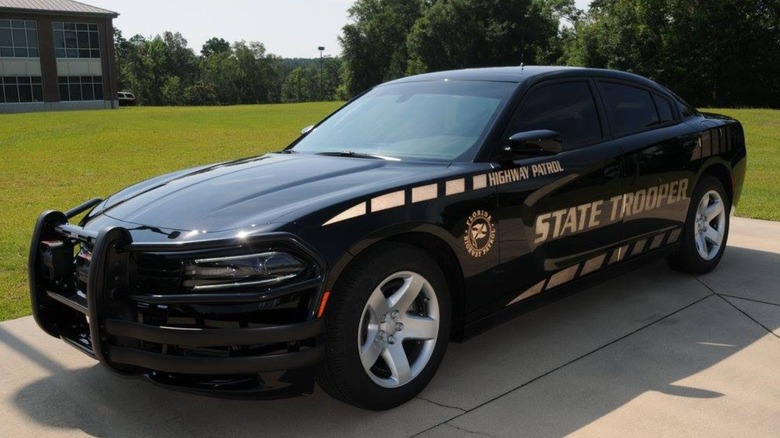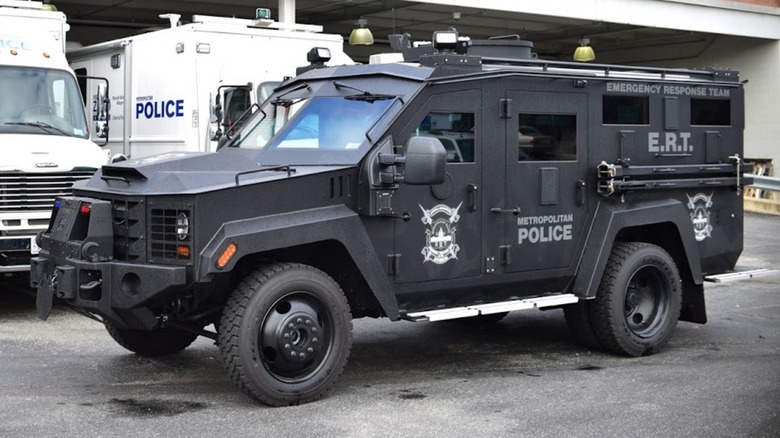Police Cars Aren't Armored For Good Reason
It's likely that many people have a negative association with police cars — or, at the very least, their lights. Nobody wants to see them flash from behind, as it may mean that a ticket with their name on it lies in their future. Pulling people over is hardly the only thing that police use their cars for, however. They are also used to transport officers to potentially violent situations in which they could be shot at or harmed. While the engine under the hood of a police car can stop or deflect almost anything shot from a firearm, however, the vast majority of police cars are not armored. Why? It's a fair question to ask because the technology does exist. After all, the Presidential limousine is up-armored.
There are several reasons why police cars aren't armored, but the primary reason is performance. When you armor a car, you remove a great deal of maneuverability and speed. Police cars need to be able to engage in high-speed pursuits, but they can't do that when you attach hundreds or thousands of pounds of ballistic glass and armored panels to the car. Another reason police cars are not typically armored is the cost it would take to do so.
Armoring a police car is expensive
When it comes to adding armor to a vehicle, there are several considerations to be made. Do you want to stop a round from a handgun or a high-powered rifle? Or, instead, is the intention to protect against explosive blasts? You can replace the windows with ballistic glass, which is bullet-resistant, but it becomes almost impossible to see through after it's hit. You can also add armor to the doors because, despite what you've seen on TV and in movies, a car door will not stop a bullet. Parties interested in armoring a vehicle could also add Kevlar run-flat tires, which allow a vehicle to keep traveling after a puncture.
Yet doing any of this is considerably expensive, and depending on the size of the police force, there could be hundreds or thousands of cars that need to be armored. This is especially true in large cities like New York or Los Angeles. Plus, when you add any of these features to a car, they increase its weight, which may put stress on other parts of the car that weren't designed to handle these alterations. Cars are engineered for performance, and adding armor can significantly impact braking, acceleration, and handling that may need to be adjusted at extra costs as well.
Overall, it can cost anywhere between $25,000 to $140,000 to up-armor a vehicle, though this depends on the manufacturer, the total amount of armor purchased, and other factors. That cost is in addition to the purchase price of the vehicle, so police departments have to weigh the cost-to-benefit ratio. In most cases, it's far too expensive to fully protect a police car.
Some specialized vehicles are up-armored
While your average police car isn't armored, that's not true of all vehicles used in the field. Some police departments are opting for armored police cars. These can feature handgun and rifle-resistant glass, run-flat tires, and pillar, door, and floor armor. There are several companies that manufacture and install these systems, but it's unclear how many police departments have purchased these protective upgrades.
Some may opt for bullet-resistant glass, while others go for the whole package. Although relatively few departments are moving in this direction, there are police vehicles that look more useful on a battlefield than in the streets of a large metropolitan city, including the pictured Lenco BearCat. These aren't used for high-speed chases, so their weight of roughly 20,000 lbs. isn't a concern. These beasts boast armor that shields against small arms and shrapnel, and they have other features that protect their occupants.
While these are among some of the coolest police cars from around the world, they're not the only heavyweight, armored behemoths on the roads. In 2011, the Tampa Police Department was spotted using an amphibious-type armored vehicle, for example. It's unclear why such a vehicle was necessary for a civil police force, though.


